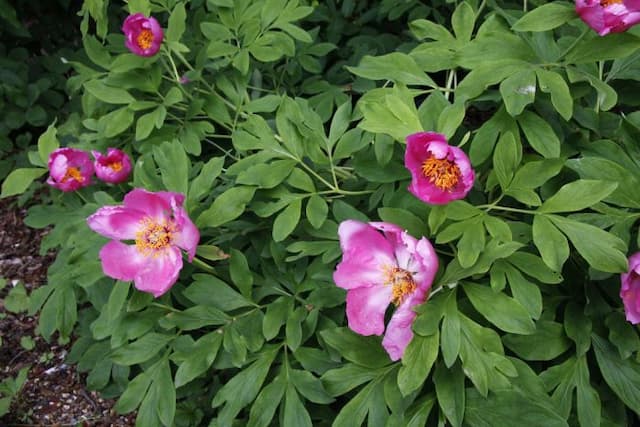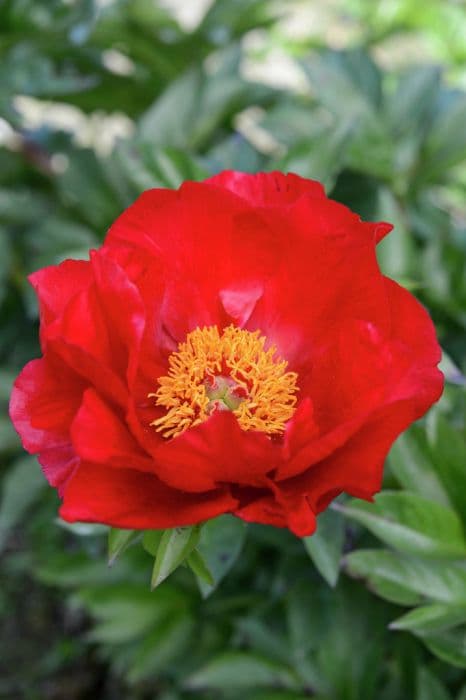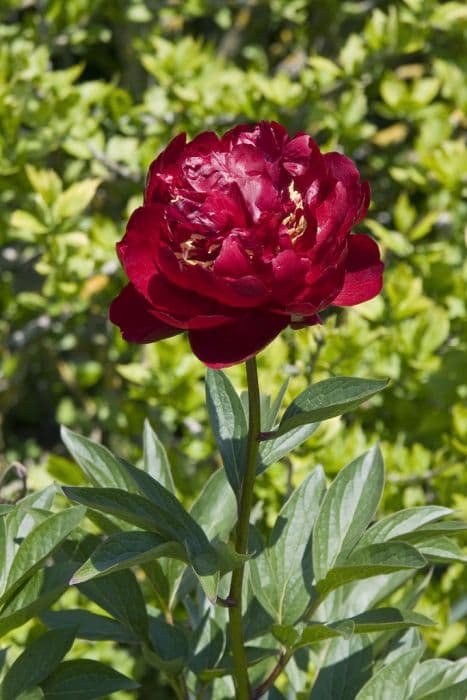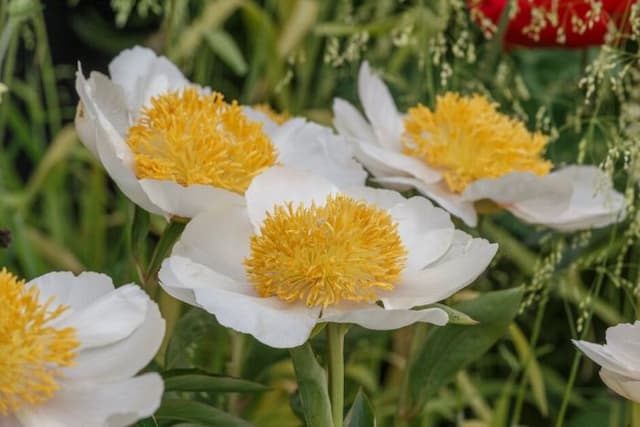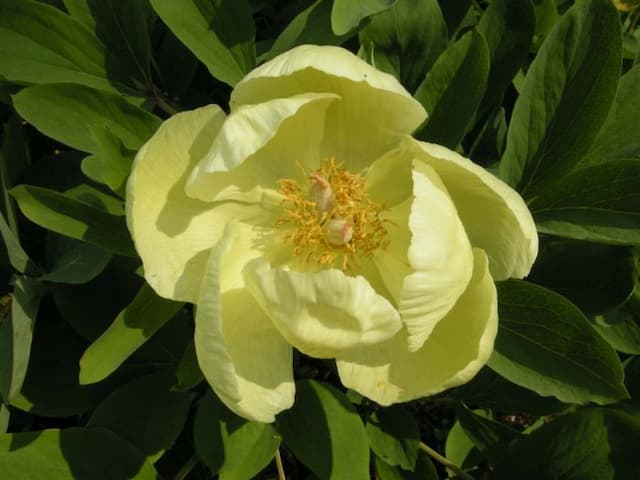Peony Paeonia lactiflora 'Félix Crousse'

ABOUT
The Paeonia lactiflora 'Félix Crousse', commonly known as the peony 'Félix Crousse', is a striking perennial plant renowned for its large, vibrant red flowers. Each bloom boasts a multitude of silky, ruffled petals that exude a lush, romantic look. The color of the flowers is a rich, deep red shade that tends to draw the eye, making it a prominent feature in any garden when in bloom. The petals may sometimes exhibit a slight silvery sheen along their edges, adding a layer of complexity to their appearance and enhancing the flower's overall attractiveness. At the center of each flower, a group of yellow stamens creates a bold contrast, enhancing the visual appeal and providing a focal point. The foliage of the peony 'Félix Crousse' is equally impressive, with leaves that are glossy and deep green, forming an elegant backdrop that makes the red flowers stand out even more. The leaves are divided into leaflets and have a somewhat leathery texture, which adds to the plant's robust appearance. Overall, the peony 'Félix Crousse' is a showy, decorative plant that is prized for its striking flowers and lush foliage, making it a beloved addition to many gardens.
About this plant
 Names
NamesFamily
Paeoniaceae
Synonyms
Chinese Peony, Common Garden Peony
Common names
Paeonia lactiflora 'Felix Crousse'.
 Toxicity
ToxicityTo humans
The plant commonly known as peony, specifically the Paeonia lactiflora 'Félix Crousse', is generally not considered highly toxic to humans. However, peonies contain compounds like paeonol which can cause mild gastrointestinal upset if ingested in significant enough quantities. Symptoms of peony ingestion may include nausea, diarrhea, and vomiting. Skin contact with the sap can sometimes cause irritation or a rash in sensitive individuals. Ingesting any part of the plant, although not typically life-threatening, could lead to these uncomfortable symptoms and care should be taken to avoid consuming it.
To pets
Peonies, such as Paeonia lactiflora 'Félix Crousse', are also not highly toxic to pets, but they can cause some mild to moderate gastrointestinal upset if ingested. In pets, symptoms of peony poisoning may include vomiting, diarrhea, and decreased appetite. While the peony is not usually considered dangerous for pets, it is still advisable to prevent them from eating any part of the plant to avoid the potential for these undesirable symptoms. If a pet has ingested a significant amount of peony and is showing signs of distress, it is best to consult a veterinarian.
 Characteristics
CharacteristicsLife cycle
Perennials
Foliage type
Deciduous
Color of leaves
Green
Flower color
Red
Height
2-3 feet (60-90 cm)
Spread
2-3 feet (60-90 cm)
Plant type
Herb
Hardiness zones
3-8
Native area
Asia
Benefits
 General Benefits
General Benefits- Aesthetic Appeal: Paeonia lactiflora 'Félix Crousse', commonly known as the Chinese peony, provides vibrant blooms that enhance the beauty of gardens and landscapes.
- Long-lasting Blooms: It is known for its ability to produce blooms that can last for several weeks, offering a prolonged display of color.
- Attracts Pollinators: The Chinese peony attracts bees and other pollinators, supporting biodiversity in the garden.
- Perennial Growth: As a perennial, it returns year after year, which reduces the need for annual planting.
- Cold Hardiness: The plant is cold-hardy, making it suitable for growth in cooler climates without the need for winter protection.
- Heritage and History: With its historical cultivar, 'Félix Crousse' is valued for its traditional charm and historical significance in horticulture.
- Versatility in Landscape Design: It can be used in a variety of garden styles, including borders, flower beds, and as a specimen plant.
- Low Maintenance: Once established, Chinese peonies require minimal care besides occasional watering and fertilizing, making them a convenient choice for gardeners of all levels.
- Cut Flower Use: The blooms are excellent for cutting and arranging in vases, where they can last for an extended period indoors.
- Deer Resistance: Peonies are generally resistant to deer, which helps to prevent damage from herbivores in the garden.
 Medical Properties
Medical Properties- Anti-inflammatory: Compounds in Peony may help reduce inflammation.
- Immunomodulatory: Peony may have effects on the immune system.
- Antispasmodic: It may help alleviate muscle spasms.
- Analgesic: Peony has been traditionally used to relieve pain.
- Antioxidant: Contains antioxidants that protect cells from damage.
 Air-purifying Qualities
Air-purifying QualitiesThis plant is not specifically known for air purifying qualities.
 Other Uses
Other Uses- Paeonia lactiflora 'Félix Crousse', commonly known as peony, can be used in the production of natural dyes for fabrics, yielding a range of soft shades through its petals.
- The petals of the peony can serve as an environmentally friendly insect repellent when crushed and rubbed onto skin or infused in water.
- Fresh or dried peony petals are sometimes used in crafting eco-friendly confetti for weddings or celebrations, as they are biodegradable and colorful.
- Peony blossoms can be used as a natural fabric softener when placed in a mesh bag and added to the dryer or in the final rinse cycle of washing.
- Paeonia lactiflora 'Félix Crousse' can be utilized as a muse for artists and photographers, inspiring works of art and being a popular subject in still life photography.
- Dried peony petals can be incorporated into homemade potpourri mixes, adding fragrance and color to a room.
- Peony petals are occasionally used in gourmet culinary creations, like crystallized for cake decorations or as a colorful garnish for high-end dishes.
- The structural foliage of the peony can be used in landscape design to provide a lush backdrop to gardens and increase visual interest even when not in bloom.
- The large peony blooms can be used as natural bowls for serving desserts, such as sorbet, adding elegance to the presentation.
- Peony flowers are sometimes featured in cultural ceremonies and traditions, symbolizing prosperity, good luck, and marital happiness in various cultures.
Interesting Facts
 Feng Shui
Feng ShuiPeony is often used in Feng Shui to promote love and romance, and it is especially beneficial when placed in the southwest sector of a garden or home, which relates to love and marriage in Feng Shui Bagua. However, the specifics of the variety such as 'Félix Crousse' may not change the basic principles of its Feng Shui application.
 Zodiac Sign Compitability
Zodiac Sign CompitabilityPeony is not used in astrology practice.
 Plant Symbolism
Plant Symbolism- Prosperity: The peony, including Paeonia lactiflora 'Félix Crousse', often symbolizes richness and abundance, owing to its full, rounded blooms that suggest a state of fullness and opulence.
- Romance: With its lush, ruffled petals and often sweet fragrance, the peony is frequently associated with romantic love and is a popular choice in wedding bouquets and decorations.
- Beauty: The intricate and showy flowers of the peony have made it a symbol of beauty in various cultures, representing the ideal of feminine allure.
- Honor: In some traditions, peonies embody honor and high esteem, possibly due to their status in history as an ornamental favorite in the gardens of the nobility.
- Compassion: The generous bloom of the peony can also be viewed as an emblem of compassion and nurturing, perhaps because of the way the flower enfolds upon itself, much like a nurturing embrace.
- Wealth: In line with its symbolism of prosperity, the peony is sometimes seen as a good omen for financial gain and is thought to bring good fortune in wealth matters.
- Happiness: The lush and vibrant nature of the peony’s bloom lends itself to associations with happiness and joy, making it a common gift to convey well wishes.
 Water
WaterPeonies, including the Félix Crousse variety, require even moisture especially during the growing season, but they do not like to sit in waterlogged soil. Water them deeply about once a week, providing 1 to 2 inches of water each time, increasing frequency during dry spells. Aim for a total of about 1 gallon per plant per week. In the fall, you can reduce watering as the plant prepares for dormancy, but do not let the soil become completely dry. Always water at the base of the plant to keep the foliage dry and prevent fungal diseases.
 Light
LightPeonies such as Félix Crousse thrive best in full sun, ideally receiving at least six hours of direct sunlight each day. Plant them in a spot where morning light is plentiful and where they are protected from the harsh late afternoon sun if possible. However, they are capable of growing in partial shade, though this may result in fewer blooms.
 Temperature
TemperatureFélix Crousse peonies prefer temperate climates and grow well in a range of temperatures, but they perform best when the summer temperatures hover between 65°F and 75°F. They can withstand winter chill down to about -20°F, which is necessary for the dormancy period. In general, avoid planting peonies in regions with extreme heat as this may inhibit blooming.
 Pruning
PruningPrune Félix Crousse peonies in the fall, cutting back the stems to about 3 inches above the ground after the first frost. This helps prevent overwintering diseases and pests, and it keeps the plant tidy. Remove any spent flowers during the bloom season to direct energy towards growth and future blooms. Pruning is typically done annually.
 Cleaning
CleaningAs needed
 Soil
SoilThe best soil mix for peonies like Paeonia lactiflora 'Félix Crousse' is well-draining, loamy soil rich in organic matter. The pH should be slightly acidic to neutral, ideally between 6.5 and 7.0. It's beneficial to amend the soil with compost and aged manure to enhance fertility. Mulching helps retain moisture and keeps the roots cool.
 Repotting
RepottingPeonies (Paeonia lactiflora 'Félix Crousse') rarely need repotting as they prefer to be left undisturbed and can thrive in the same spot for many years. If necessary, repotting should be done in the fall, and typically no more than once every 10 to 15 years, unless the plant outgrows its space or soil conditions deteriorate.
 Humidity & Misting
Humidity & MistingPeonies like Paeonia lactiflora 'Félix Crousse' are tolerant of a wide range of humidity levels and do not require high humidity. They thrive in the ambient moisture levels commonly found outdoors. In general, they prefer drier conditions over excessive humidity to prevent fungal diseases.
 Suitable locations
Suitable locationsIndoor
Peonies need cold to bloom; hard to grow indoors.
Outdoor
Plant in full sun, rich soil, water deeply and mulch.
Hardiness zone
3-8 USDA
 Life cycle
Life cycleThe "Félix Crousse" peony, a variety of Paeonia lactiflora, begins its life as a dormant tuber which is usually planted in the fall. This tuber then gives rise to shoots in the spring, marking the onset of the vegetative growth stage during which roots, stems, and foliage develop. As the peony matures, it reaches the flowering stage in late spring to early summer, producing large, fragrant, deep pink flowers. Once pollinated, possibly by insects attracted to its color and scent, the peony may develop seed pods that ripen by late summer. If conditions are favorable, the seeds can be dispersed and may eventually germinate to produce new plants, continuing the cycle. After flowering, the plant enters a period of dormancy as leaves yellow and die back with the onset of fall, conserving energy in its tuber for the next growing season.
 Propogation
PropogationPropogation time
Early spring
The most popular method for propagating the common peony, known scientifically as Paeonia lactiflora 'Félix Crousse', is through division. This process is best done in the fall, when the plant has gone dormant after the flowering season. To propagate by division, the clump of the peony should be carefully dug up and the excess soil gently shaken off to reveal the root structure. The root ball is then divided into smaller sections, ensuring that each section has at least 3-5 eyes, which are the growth nodes from which the new shoots will emerge. The divided sections can then be replanted at the same soil depth they were growing at previously, spacing them about 3 feet (approximately 0.9 meters) apart to allow room for growth. Adequate watering and avoidance of deep planting are crucial as this can prevent the peony from blooming.
